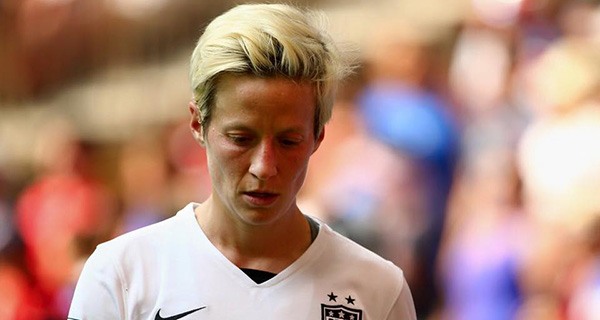 The men’s final at Wimbledon on Sunday took five immortal sets of tennis over four hours 57 minutes before Novak Djokovic finally outlasted Roger Federer in a stirring contest that ended in a fifth-set tiebreaker at 13-12.
The men’s final at Wimbledon on Sunday took five immortal sets of tennis over four hours 57 minutes before Novak Djokovic finally outlasted Roger Federer in a stirring contest that ended in a fifth-set tiebreaker at 13-12.
Saturday’s women’s final lasted just 56 minutes in two quick sets for Simona Halep to upset Serena Williams. It was over before the clotted cream could go sour on the famed Wimbledon strawberries.
So equal pay for work of equal value? Or why don’t women have to play the same number of sets to cash an equal cheque at The Championships?
Surely no one is making the case that women are (gasp) physically unable to play five sets, are they? After all, women marathoners run the same distance as men.
Critics will say you can’t judge the value of the work based on length of a performance. You must consider economic impact. If women athletes are generating the same money as men, then they deserve to have an equal share, right?
Fine. If we’re talking market forces in tennis, it’s hard to separate men’s and women’s impact in Grand Slam events where the two are co-mingled. But when tournaments are staged separately, men’s attendance and TV ratings consistently top women’s tennis. Take Williams out of the equation (as will happen soon, since she turns 38 shortly), and women’s tennis will be dwarfed by its male counterpart.
Need more?
| RELATED CONTENT | |
| Phil Mickelson wins one for the ages By Michael Taube |
|
| Why don’t Canadian broadcasters love the beautiful game? By Peter Menzies |
|
| Analytics destroying baseball’s entertainment value By Ken Reed |
|
|
Take the recently completed women’s World Cup of soccer. The previous women’s World Cup brought in $134 million. The previous men’s World Cup earned $6 billion. Professional men’s soccer attendance averages multiple tens of thousands. Women’s pro soccer is lucky to average 5,000 a game.
Television ratings?
Outside the World Cup and Olympics, women’s soccer has no visibility on TV. Men’s soccer is the most popular TV sport in the world, drawing billions to its telecasts globally.
Yet Megan Rapinoe and the champion American team were everywhere last week demanding equal pay to the men for their efforts. They claimed they were being discriminated against. The players garnished their message to the media and politicians with some Colin Kaepernick techniques, refusing to stand for the national anthem, etc.
Needless to say, the woke elements in media were all over it, demanding market forces be ignored. (The champion Americans now are paid about US$75,000 by their sport officials. They can earn more through sponsorship or advertising.)
So where is the money supposed to come from to equal Rapinoe’s pay with that of Lionel Messi or Paul Pogba?
Clearly, women’s soccer does not generate the money men’s soccer does. In calling their treatment unfair, the women players seemed to be implying that public money should be shifted to benefit them.
Their political supporters also seemed to think that disadvantaged women athletes needed to be taken care of. They’ve married the plight (?) of the women soccer players to the movement for a higher minimum wage, equal pay and alleged discrimination against women. The fact that many on the American team are openly gay was also used to ratchet up the victim status of the soccer women.
The problem Rapinoe and her colleagues have – one that they share with women in many but not all sports – is that they can’t even make the sale to their fellow women. Women make up 51 per cent of the population. Yet outside of a few sports like figure skating or during Olympiads, their fellow women take a pass on buying tickets or cable TV subscriptions to watch them.
(It doesn’t help the optics that the women’s soccer team was reportedly beaten by a team of 14-year-old boys or that the women’s national hockey team is likewise unable to beat midget hockey teams.)
Supporters of women’s sports say they can’t get a toehold because the media is against them. They call it a vicious cycle. But the National Basketball Association has underwritten the Women’s National Basketball Association (WNBA) for years. Despite making WNBA tickets compulsory for season-ticket holders in a number of cities, 2018 attendance was down to just over 6,000 a game. (The Toronto Raptors do not even sponsor a WNBA team.) TV ratings are minimal.
And we’ve recently seen the demise of another women’s league due to poor economic results. Despite the success of the Canadian national team, the Canadian Women’s Hockey League collapsed in the spring for financial reasons. Bitter players blamed the National Hockey League for not financing their league – as happens with the NBA – but commissioner Gary Bettman says that the workable models for a league to sell women’s hockey are not there.
So we return to the debate over equal pay. No one denies that the women are fine athletes. But how is it in the public interest to create sports welfare for athletes who cannot manage to convince even their fellow women that their sports deserve a wider audience?
Until the supporters of women’s sport answer that question, they’ll have to fight the status as second-tier entertainment.
Troy Media columnist Bruce Dowbiggin career includes successful stints in television, radio and print. A two-time winner of the Gemini Award as Canada’s top television sports broadcaster, he is also the publisher of Not The Public Broadcaster.
The views, opinions and positions expressed by columnists and contributors are the author’s alone. They do not inherently or expressly reflect the views, opinions and/or positions of our publication.


